Is social media really that bad? Can too much of it make you a social media addict? While the social media advent has delivered numerous benefits such as unprecedented availability of information and overall connectivity, the data that 1 in 3 divorces in the US happen because of social media disagreements is scary. This brings the question: how much is too much? Our list of jaw-dropping social media addiction statistics provides some cold, hard facts about this phenomenon. So, read on to get a clearer grasp of the problem and how it impacts our lives.
Social Media Addiction Statistics (Editor’s Pick)
- Estimates suggest that more than 210 million people worldwide suffer from addiction to social media and the internet. (Science Direct)
- Symptoms of depression are twice as likely to appear in teens who spend five to seven hours a day on their smartphones. (NPR)
- Not being on social media causes the fear of missing out in 34% of young adults. (CBS)
- Checking social media while driving happens to 55% of drivers. (Shop Owner Mag)
- A massive 43% of teenagers feel bad if no one likes their post. (Statista)
- 71% of all Americans log in to check their Facebook on a daily basis. (Pew Research Center)
Social Media Addiction Stats Breakdown
1. By 2025, the monthly number of active social network users is expected to reach 4.41 billion.
One of the more shocking social media facts and stats is that by 2025, the monthly number of active social media users is expected to reach 4.41 billion globally, according to Statista. To put that into perspective, that is about one-third of the world’s entire population. It’s important to mention that the number of social media uses has been gradually increasing since 2017.
(Statista)
2. Social media is currently home to nearly 58.5% of the world population.
A Smart Insights study recently revealed that more than half of the global population is active on social media in some form or another in 2022. That means that roughly 4.62 billion people now use social media. Also, the average usage per day amounts to 2 hours and 27 minutes. The study further suggests that this number has been growing due to multi-networking. Facts about social media addiction establish that the growing adoption of these platforms causes dramatic spikes in usage by certain age groups which often leads to uncontrollable or excessive use of social media.
(Smart Insights)
3. More than 200 million people worldwide are estimated to suffer from addiction to social media and the internet.
Human dependence on technology grows by the day and is reflected in the growing number of solutions designed to make life simpler and hassle-free. But is technological advancement risk-free? Social media addiction research reveals that some 210 million people worldwide suffer from some form of internet and social media addiction. Studies further suggest that the situation will only get worse.
(Influencer Marketing Hub)
4. Social media sees some teens spending more than seven hours each day logged in.
While teenagers all over the world have a tendency to use digital technologies excessively, social media addiction facts also reveal that American teens spend 7 hours and 22 minutes on average per day browsing through various social media. One reason for this is that being in one’s teens usually means having plenty of free time and devices that are more accessible. For instance, 53% of children own a smartphone by the time they’re 11.
(Common Sense Media)
5. Symptoms of depression are twice as likely to appear in teens who spend more than 5 hours a day on their smartphones.
Internet and social media addiction facts show that teenagers who spend between five and seven hours each day are twice as likely to suffer from symptoms of depression compared to their counterparts that only use their smartphones for one hour per day. This goes to show that the consequences of accessibility to social media and technology may be more serious than expected.
(NPR)
6. Dangers of social media statistics confirm that 90% of people aged 18-29 use social media in any form available.
Social media consumption is most frequent among the youngest adults. According to Statista’s report, a staggering 90% of people aged 18-29 state that they use social media in any form available, meaning they are at the highest risk of becoming social media addicts. Those aged 30-49 have a smaller share of 82%. The stats keep lowering as the age of participants goes up, with those aged 50-64 reporting 69% consumption and the 65+ age group going as low as 40%.
(Statista)
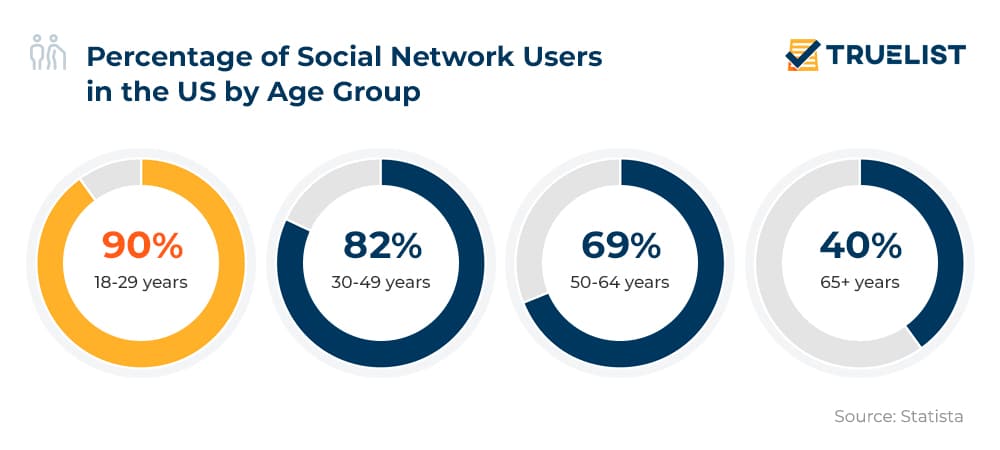
7. Social media addiction statistics reveal 15% of people aged 23-38 admit they are addicted to social media.
And if you think 15% is low, let’s look at the other data in Statista’s social media addiction research. When asked whether the statement “I am addicted to social media” somewhat or completely describes them, 30% of all surveyed said ‘somewhat’ while 9% said they feel they are social media addicts. The percentage of people feeling ‘somewhat’ addicted to social media is highest at 40% among those aged 18-22 and 37% among people between 23 and 38. Then, 9% of people between the ages of 39 and 54 feel they are addicted.
(Statista)
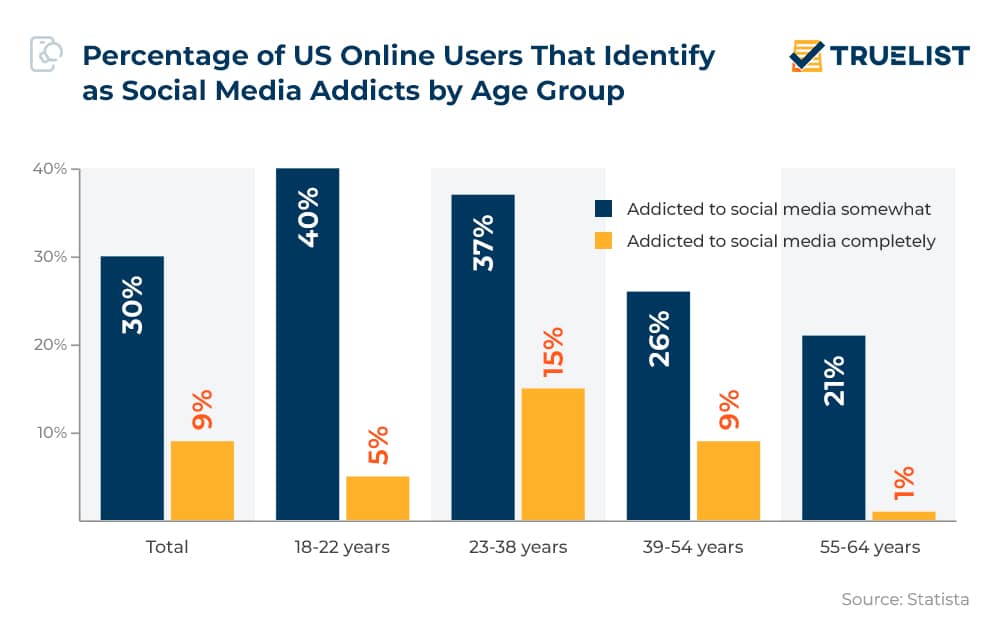
8. Compared to every other group, young single females are the most addicted to social media.
When discussing social media addiction statistics and trends, addictive social media behavior is most strongly associated with being a young, single female. According to a social media addiction study involving more than 23,500 participants with ages ranging from 16 to 88, this is the age group that is most likely to display addiction symptoms. Overall low self-esteem and a narcissistic personality were also very strongly associated with addictive social media behavior.
(Science Direct)
9. 350 thousand tweets are sent every minute of the day.
Statistics like this one prove that the Internet and digital technology have a great impact on people’s lives. To be more precise, 694 thousand TikTok videos are watched every minute of the day, along with 694 thousand YouTube videos. Also, there are 4.1 thousand clicks on sponsored Instagram posts per minute, which seems good for social media marketing firms. Still, this much data is an issue for marketers who search for best practices in different areas.
(Smart Insights)
What Are the Effects of Social Media Addiction?
10. Social media disagreements between couples account for 1 in every 3 divorces.
Many relationships suffer because of excessive use of social media. Failed marriages and ruined relationships are often listed as the most devastating social media addiction effects. This happens because some people believe monitoring one’s romantic partner on social media is harmless when instead it often leads to jealousy and quarrels. Facebook addiction statistics reveal this platform is involved in the vast majority of such marital disputes, 1 in 3 of which end in divorce. In fact, divorce attorneys no longer shy away from using networking sites to derive data which is then used as evidence.
(HG)
11. Not being on social media causes the fear of missing out in 34% of young adults.
Yet another finding related to the negative effects these platforms have (on young people, in particular) has been provided by social media addiction stats. The FOMO (fear of missing out) phenomenon manifests in 34% of young adults who feel uneasy when they are not online and another 22% who get restless when logged out because they cannot check incoming messages. Recent research indicates that anxiety kicks in in a surprisingly high number of people once they log out of social media though this symptom rarely appears in older social media users.
(CBS)
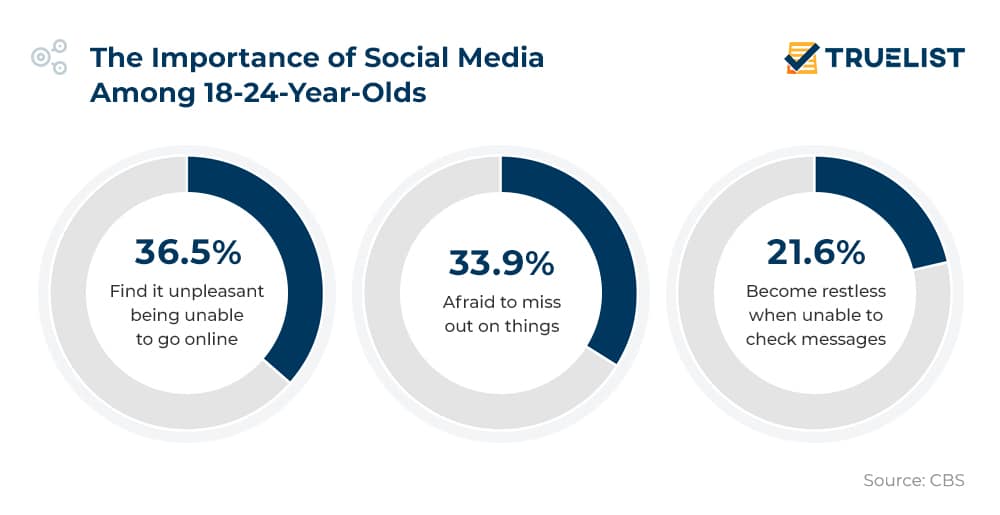
12. Checking social media while driving happens to 55% of drivers.
When it comes to how social media addiction affects your life, younger and less experienced drivers have a nasty habit of checking social media while behind the wheel. Studies performed around the world have concluded that using your smartphone in any capacity while driving is both dangerous and widespread. According to a study, 30% of drivers say they’ve checked Facebook while driving, 20% checked Instagram, and 17% checked Snapchat.
(Shop Owner Mag)
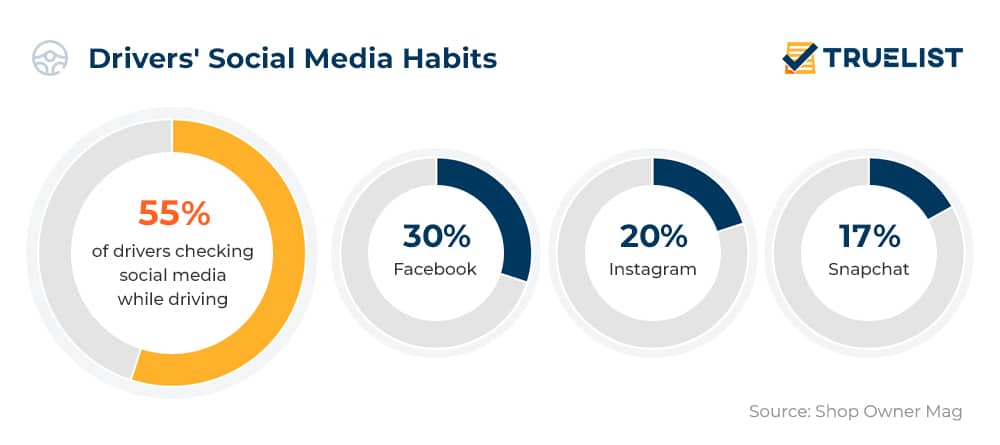
13. 40.6% of young adults complain their sleep has been affected by social media.
Statistics on social media addiction disclose the number of young adults experiencing social media addiction symptoms which often pass unnoticed is growing by the day. Since 2015, the number of young adults experiencing sleep issues notes a disturbing jump from 26% to approximately 41%. The same study on social media addiction effects shows 35.1% of young adults displaying bad results in their academic performance and again this percentage has increased from 22.8% back in 2015.
(CBS)
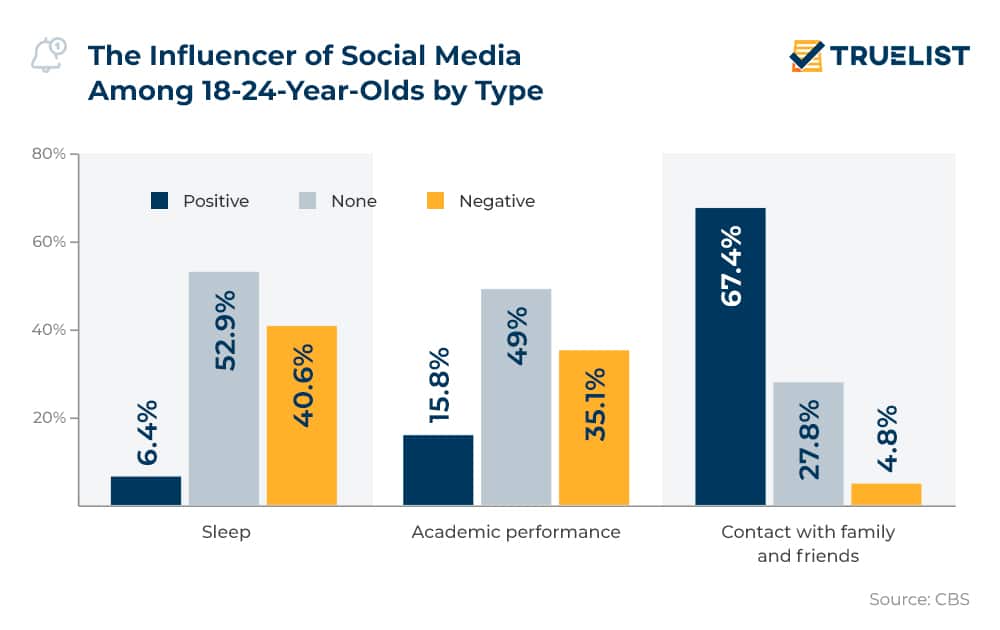
14. A massive 43% of teenagers feel bad if no one likes their post.
The fact that, according to social media addiction facts, 70% of US teenagers feel left out or excluded when using social media is more than distressing. More stats reveal that 43% of teens delete their posts because they didn’t get the number of likes they were aiming for and another 43% feel absolutely devastated because no one likes their posts. But perhaps the most alarming data is that 35% of teens with low social-emotional well-being said they have been cyberbullied when using social media.
(Statista)
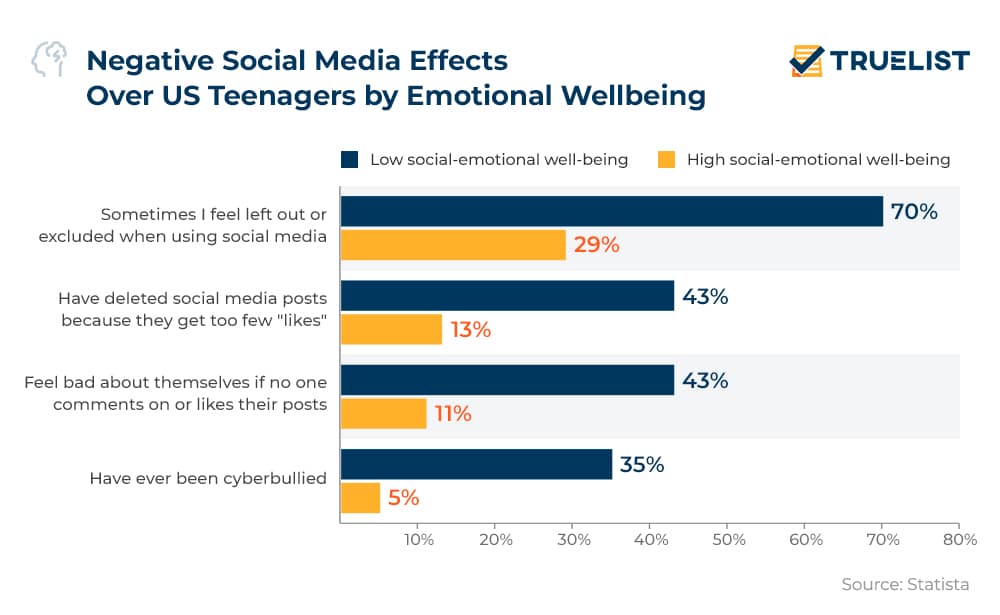
15. 7 in 10 teens who use social media for over 5 hours are at higher risk of committing suicide.
In relation to the harmful effects and the dangers of social media, statistics indicate that when smartphones first appeared there was a sudden spike in depression symptoms, suicide risk factors, and rates in the teenage population. Taking into account the data that the majority of US teens (95%) own a smartphone and are obsessed with checking their phones, a recent social media addiction study revealed that a staggering 71% of teens who spend over 5 hours a day on social media are more vulnerable to suicide compared to their peers who ‘socialize’ for an hour or so.
(NPR)
Facebook Addiction Statistics
16. Facebook had more than 2.93 billion monthly active users in the first quarter of 2022.
Stats like this one show that this is the biggest and most used social media platform in the world. The data regarding Facebook points out that there has been a steady increase in Facebook monthly users since 2008. In addition, the number of daily Facebook users during the first quarter of 2022 was 1,960. The greatest concern here is that perpetual habits such as these are considered unhealthy and leading causes of social media addiction.
(Statista)
17. As of January 2021, an average American spent about 33 minutes a day on Facebook.
Social media addiction stats show that the average American Facebook user spends around 33 minutes daily browsing the social network. Also, Facebook had the largest amount of time spent per day during the same period. The main reason for spending time on social media was the coronavirus pandemic.
(Statista)
18. 71% of all Americans log in to check their Facebook on a daily basis.
The fact that nearly 7 out of 10 Americans are Facebook users is hardly surprising. Social media addiction statistics, however, indicate that 71% of them sign in and check the app at least once a day and a massive 49% do it several times a day. The stats are in line with those from 2016 when the social network experienced a remarkable usage growth in the US but the sad part is the borderline addictive behavior of users also remains consistent.
(Pew Research Center)
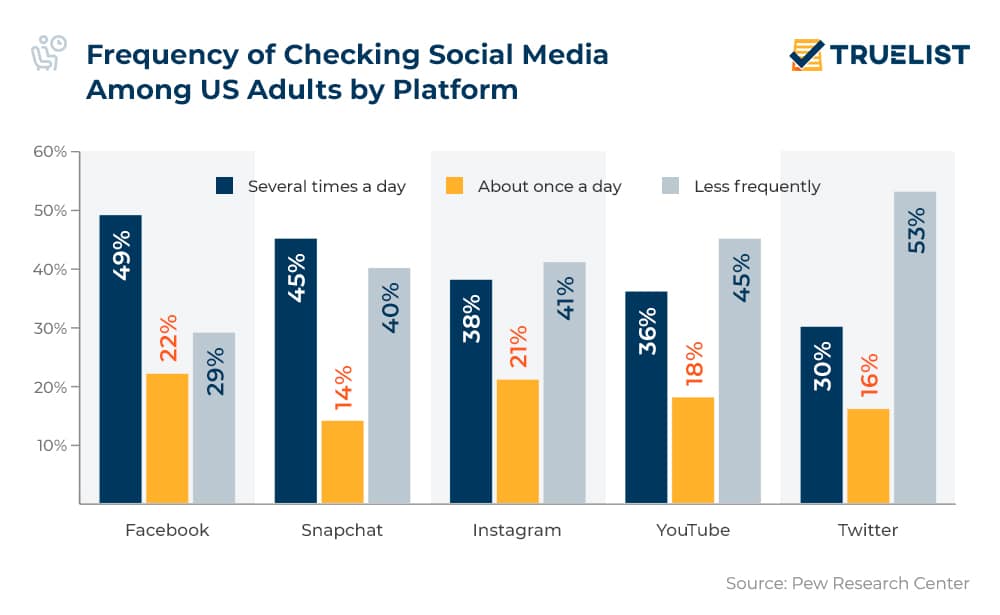
Social Media Addiction FAQ
What is social media addiction?
Social media addiction is described as an uncontrollable urge to use the internet and social media, leading to a state where one is overly concerned when they are not online. Social media addiction facts show that the dependency impairs other important areas of their life because they devote so much effort and time to their social media cravings. Psychologists today estimate that anywhere between 5% and 10% of Americans are suffering from this condition.
What age group is most addicted to social media?
Data about millennials and social media reveal their age group is most prone to become social media addicts. This is mainly because they love to share and inspire, thinking in this way they will be better able to express themselves. Studies about addiction to social media also show they do it because they like to show off and get comments and likes. However, their main drive in this endeavor is that they are absolutely mortified of missing out on vital information.
How do you deal with social media addiction?
There is no simple answer to this question as solving this problem must take place over time with the understanding that it is a process, not an instant fix. That said, quitting cold turkey is an efficient method, though not many are capable of following through. That’s why taking it one step at a time is a more viable alternative. For example, switching to meeting people in real life is a good first step, which you can supplement by making social media a treat to reward yourself occasionally. Another social media addiction treatment is to start spending more time with your loved ones or pick up a new hobby to invest your time in, as well as simply turn off your notifications permanently.
Conclusion
While there is no denying that the internet has made our lives simpler and better in many aspects, it is not without consequences. Social media addiction statistics underscore the negative effects of the overuse of digital technologies, especially for mental health and overall social-emotional well-being. Unplugging from social media, therefore, is something everyone needs to do every once in a while.
Sources: Science Direct, NPR, CBS, Shop Owner Mag, Statista, Pew Research Center, Statista, Smart Insights, Influencer Marketing Hub, Common Sense Media, Statista, Statista, Science Direct, Smart Insights, HG, NPR, Statista, Statista, Statista

